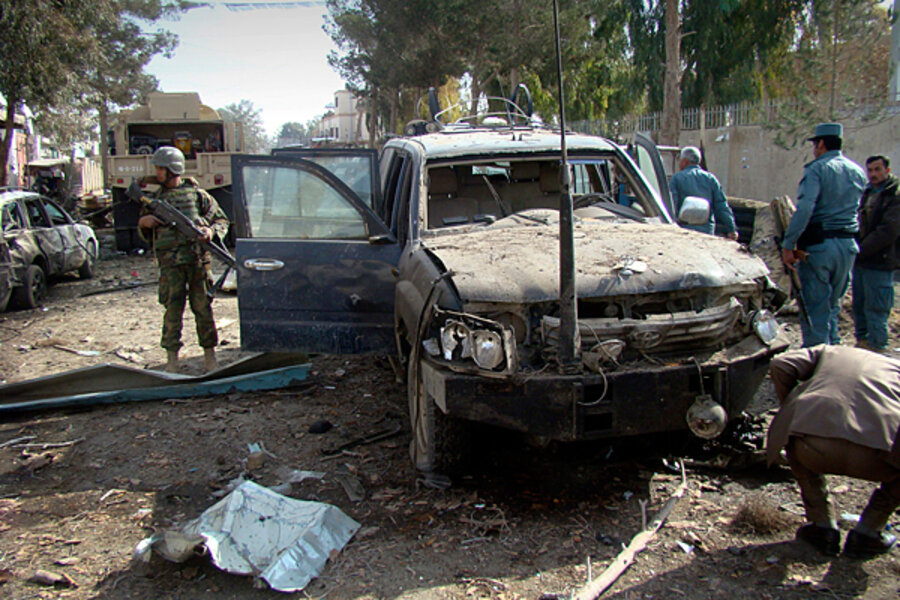Taliban attacks in Afghanistan not down after all
Loading...
Was the war in Afghanistan going better in 2012 than it was in 2011?
At first, it seemed clear the answer was yes, with a claim from the International Security Assistance Force (ISAF) in January that last year, attacks by the Taliban against foreign and Afghan government troops had fallen 7 percent from the previous year.
But that report was later quietly withdrawn from the ISAF website (ISAF is the US-led NATO coalition in Afghanistan). And on Tuesday, NATO said there was no decline in Taliban attacks, the final year of President Obama's "surge" in Afghanistan, after all.
Statistics about the Afghan war have long been a spin game, with consistent efforts made out of ISAF and elsewhere to argue that major gains are just around the corner. When the data shows improvement, it's trumpeted as evidence. When the data shows the opposite, well, improvement is still assured.
ISAF spokeswoman Erin Stattel told the BBC Tuesday in an interview about the revision of the statistics: "In spite of this data adjustment, our assessment of the fundamentals of campaign progress has not changed ... the enemy is increasingly separated from the population and the ANSF [Afghan National Security Force] are currently in the lead for the vast majority of partnered operations."
Her comments appear to be approved talking points, given that Pentagon Spokesman George Little said precisely the same thing to reporters in Washington yesterday. Speaking earlier to Robert Burns of the Associated Press, whose prodding led ISAF to admit the error, Mr. Little, likewise, insisted that the failure of the attack figures to show progress should be discounted. "This particular set of metrics doesn't tell the full story of progress against the Taliban, of course, but it's unhelpful to have inaccurate information in our systems," Little said.
The incorrect claim has inflected much of the US military and Obama administration commentary about the war. Speaking to reporters on Dec. 18, Defense Secretary Leon Panetta was asked about an apparent increase in violence in Afghanistan. He responded:
Well, you know, the reality is that, in the period that was included there, there was a slight increase in attacks, but the overall numbers – if you look at the entire year, the level of violence is down. It's down by almost 60 percent in Kabul, it's down by almost 50 percent to 60 percent in other populated areas where we've made the transition. The violence levels are down.
The fact is that the Afghan army, the Afghan police have gotten much better at providing security in those areas that we transitioned to... the Taliban is resilient, and they will continue to try to conduct attacks. They'll continue to do IED attacks. They'll continue to try to do high-profile assassinations. They'll continue to try to do what they can to draw attention to their efforts. But overall they are -- they are losing. They have not been able to regain any territory that they've lost.
Does accurate reporting matter?
Anthony Cordesman, a senior fellow at the Center for Strategic and International Studies in Washington and a former director of intelligence assessment in the office of the US secretary of Defense, had long argued that it does, in both the Afghanistan and Iraq wars. Last June, in a long piece assessing the probability of a successful transition in Afghanistan, he took square aim at the credibility of progress reports from the war, saying they're hurting whatever chances there are of success.
The Afghan government, the US and its allies, and aid donors have not made enough collective progress to assign a clear level of probability.... If they are to succeed, major improvements must take place in the depth and quality of planning and analysis, as well as in the transparency, credibility, and integrity of reporting within the US government, allied government, ISAF, and international institutions. To date, all have failed to properly meet these tests; and most public studies and reports have relied on hype, skewed reporting, vague analysis, and good intentions. This may cover the needs of domestic politics and provide for a de facto exit during 2013-2015, but it cannot support an effective transition.
Cordesman's assessment on Jan. 23 of this year was bleaker still, when he opened by writing: "The more one looks at Afghanistan today, the more likely it seems that transition will at best produce a weak and divided state and at worst a state that either continues its civil war or comes under Taliban and extremist control. In that report, Cordesman is particularly scathing of ISAF assertions that a decline in "enemy-initiated attacks" is evidence of Taliban weakness.
For instance, in the case of Helmand, a province where US and British troops have fought hard for years and that was a major focus of the surge, he argues that a decline in attacks started by the Taliban does "little more than show that the insurgents stopped making attacks they know would result in major losses during the peak of the surge in 2010. This 'positive' trend largely vanishes in 2011 as the insurgents focused on attacks that would give them political visibility or which they thought will produce favorable results."
It is of course possible that fights with the Taliban could decline completely, but not necessarily be great news ahead of an impending NATO military withdrawal at the end of next year. The Taliban are Afghans and they live there. We don't. If they can avoid fights with tactically superior foes while they wait for a chance to take on an Afghan military and police that have less direct support from NATO, that might be a wise course of action.
And pressure from foreign troops is already declining. President Obama expects the US troop presence in Afghanistan to be cut in half by the end of this year, and Afghan President Hamid Karzai has been taking steps lately to limit what the US can do – this month banning Afghan forces from calling on NATO for air support, and ordering US Special Forces out of Wardak Province, which borders Kabul and has significant insurgent activity.
Halting the Taliban's "momentum" was a stated goal of the just-completed surge, which was promised by Obama in a speech at West Point in December 2009 and ended last fall.
Here's what the president said in 2009: "We must reverse the Taliban's momentum and deny it the ability to overthrow the government. And we must strengthen the capacity of Afghanistan's security forces and government so that they can take lead responsibility for Afghanistan's future."
But this has never been a conventional war, with foreign and Afghan troops battling for physical territory with the Taliban, the sheer denial of which would deliver a crushing blow. The Taliban has learned to adapt and avoid superior foes, and remains powerful. Are its members less capable of overthrowing the Afghan government today than they were then? Hard to say.
Billions of dollars have been spent training and equipping the Afghan National Army, and they're surely more capable then they three years ago. Capable enough? That's the billion-dollar question, quite literally. The ANA continues to rely on the US for financing and logistics, and that's going to remain true after 2014. The US spent $6.5 billion training and equipping and financing the ANA last year.








